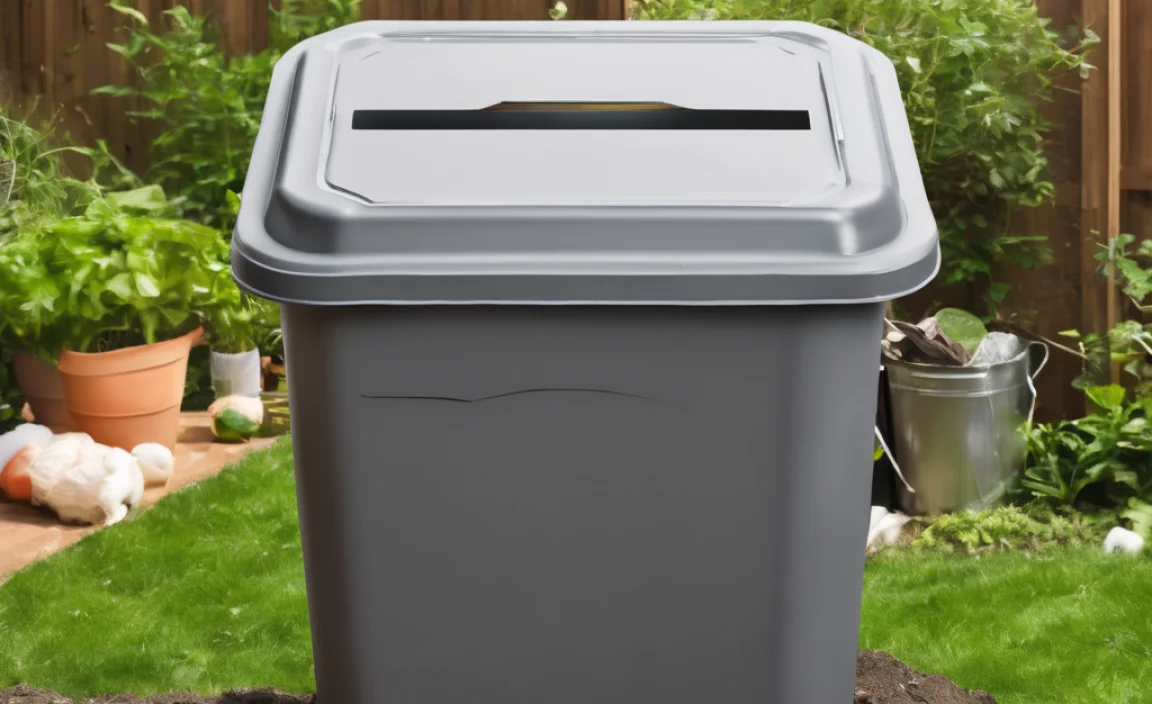Hey there, eco-warriors! Troy D Harn here, your go-to neighbor for making home projects and gardening a breeze. Ever tossed some kitchen scraps into a bin, hoping for magic to happen, only to end up with a stinky mess? You’re not alone! Composting can seem a bit tricky, especially when you’re just starting. But what if I told you there’s a super simple way to speed things up and keep things tidy?
That’s where compost bags come in! I’m going to walk you through everything you need to know about them, so you can pick the perfect one and get composting like a pro. Ready to turn those leftovers into garden gold?
Compost Bags Comparison: Your Essential Beginner’s Guide
Composting is a fantastic way to reduce waste and create nutrient-rich food for your garden. But let’s be honest, sometimes the traditional composting methods can feel slow, messy, or just… complicated. If you’re looking for a faster, cleaner, and often more compact way to compost, compost bags might be your new best friend. They’re designed to help break down your organic materials more efficiently, and they come in various forms, each with its own perks.
As Troy D Harn, I’ve seen a lot of folks get a little daunted by composting. My job is to break it down so it feels as easy as watering your plants. Today, we’re diving deep into the world of compost bags. We’ll compare different types, look at what makes a good one, and help you figure out which one is the right fit for your home and your garden goals. Think of this as your friendly roadmap to composting success, no green thumb required!
Why Consider Compost Bags?
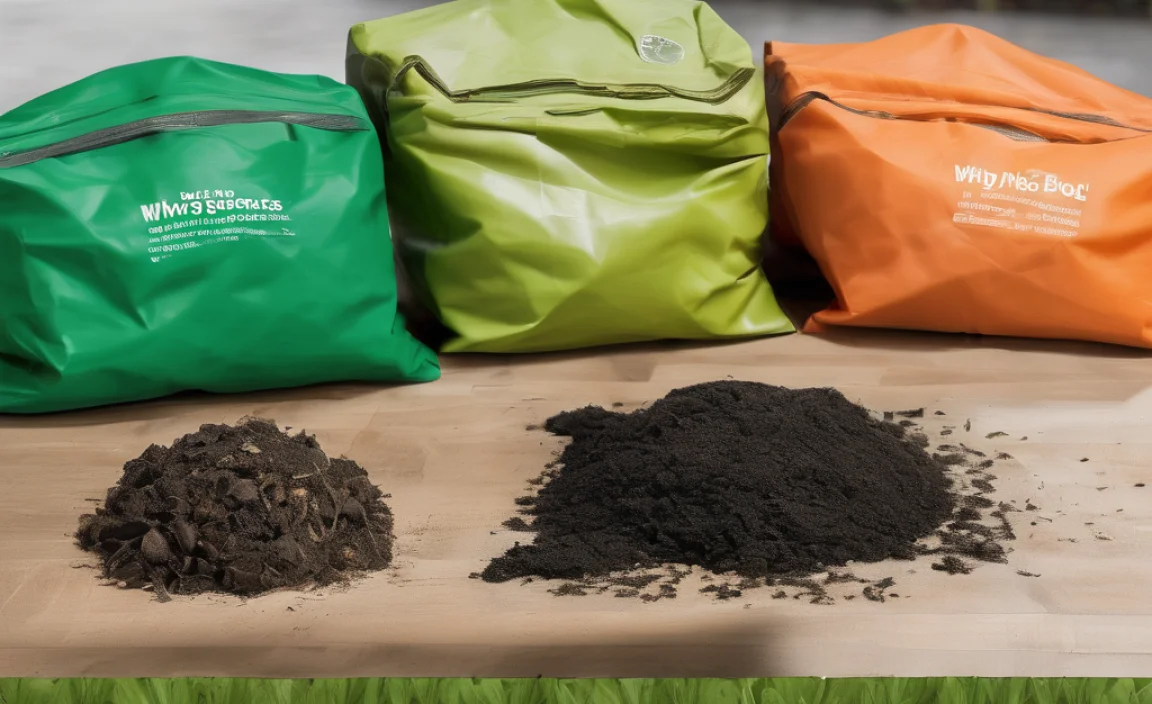
Traditional composting often involves a large bin or pile that needs regular turning and maintaining the right moisture and air balance. While effective, this can take months, sometimes even a year, to produce finished compost. Compost bags offer a solution for those of us who want:
- Faster Results: Many compost bag designs promote better aeration and moisture retention, which can significantly speed up the decomposition process.
- Reduced Odors: Good airflow and a contained environment can help minimize unpleasant smells, making composting more pleasant, especially in smaller spaces.
- Space Efficiency: Compost bags are often a great option for apartment dwellers, small yards, or anyone with limited outdoor space.
- Easier Management: Some bags are designed for simple loading and unloading, cutting down on the “turning” aspect that can deter beginners.
- Pest Deterrence: A good compost bag can help keep curious critters out of your composting material.
Types of Compost Bags: What Are Your Options?
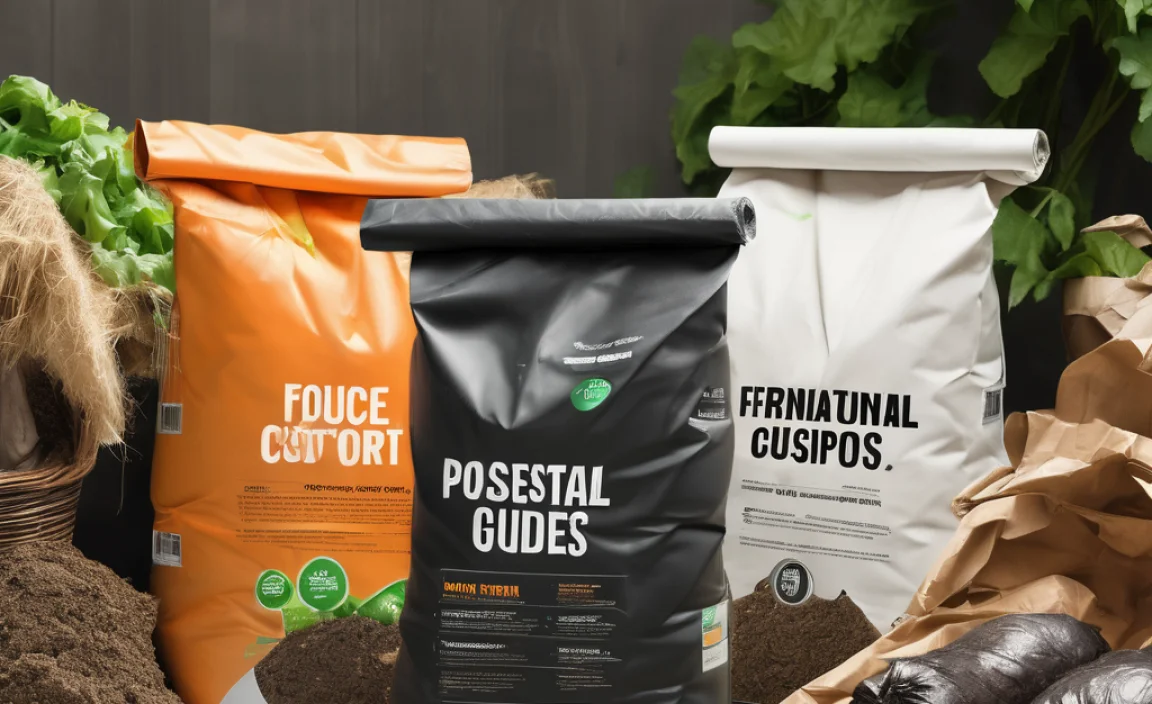
When we talk about “compost bags,” it can refer to a couple of different things, mostly depending on what you’re trying to achieve. We’ve got the bags that help you compost, and then we have the bags that are compostable themselves, often used for collecting organic waste before it goes into a larger composting system.
1. Compost Tumblers and Aerated Bins (Bag-like Structure)
These are often what people first envision when thinking of a “compost bag” as a composting system. They are designed to hold compostables and facilitate the breakdown process. While not always made of flexible “bag” material, they function similarly to a contained composting unit.
- Features: Often made of sturdy plastic or metal, with lids and sometimes aeration vents or rotating mechanisms (tumblers).
- Pros: Excellent at containing materials, reducing odors, and deterring pests. Tumblers make mixing easy. Generally produce compost faster than open piles.
- Cons: Can be more expensive upfront. Some can be bulky. Require some assembly.
- Best For: Gardeners with a small to medium yard who want efficient, odor-controlled composting and quicker results.
2. Geotextile Fabric Compost Bags
These are more like large, durable fabric sacks designed specifically for composting. They’re typically made from breathable materials like polypropylene or other synthetic fabrics that allow for good air circulation.
- Features: Breathable fabric, often with a flap or opening at the bottom for easy compost harvesting. Simple, open-top design.
- Pros: Excellent aeration, which is crucial for healthy composting and preventing anaerobic (smelly) conditions. Lightweight and portable. Relatively affordable.
- Cons: May dry out faster in hot, dry climates. Less pest-proof than solid bins. Might not look as tidy as a rigid bin.
- Reputable Materials: Look for bags made from UV-resistant, durable geotextile fabrics. Companies like GRWO often offer robust options.
- Best For: Those who want good aeration and a simple, cost-effective composting solution. Excellent for smaller spaces or as a secondary composting unit.
3. Biodegradable Compost Collection Bags
These are the bags you might use at home to collect your kitchen scraps before taking them to a larger compost bin, a municipal collection, or a commercial composting facility. They are designed to break down along with the organic waste.
- Features: Made from plant-based materials (like corn starch) that are certified compostable. Available in various sizes.
- Pros: Convenient for a zero-waste kitchen. Designed to compost along with your scraps, adding to the final compost. Reduce the need to wash out collection bins.
- Cons: Can be more expensive than regular trash bags. May become fragile if they get wet or are used for a long time. Crucially, they must be used in a proper composting environment or commercial facility to break down correctly; they won’t just disappear in a landfill.
- Certification Matters: Always look for certifications like BPI (Biodegradable Products Institute) or CMA (Compost Manufacturing Alliance). This ensures they will break down under composting conditions. Check out resources from the U.S. Environmental Protection Agency (EPA) for more on proper composting practices.
- Best For: Collecting kitchen scraps for curbside compost programs, or for use with a home composting system where the bag contents are regularly added.
What to Look for in a Compost Bag for Composting
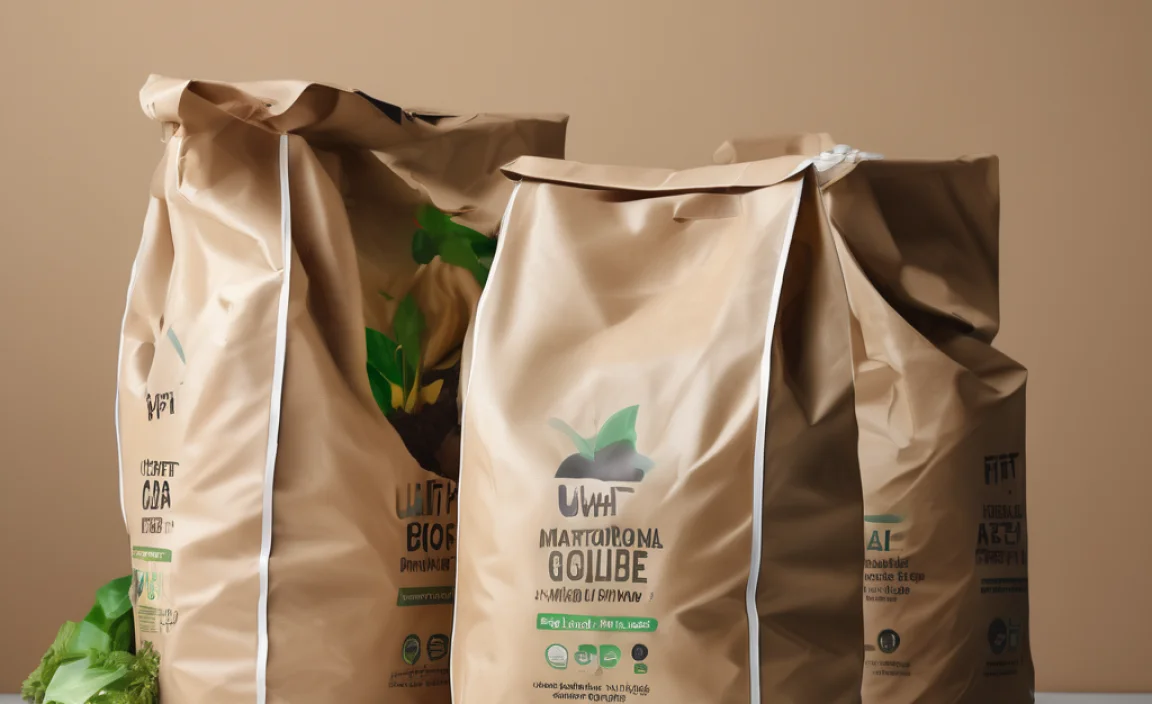
If you’re looking at bags designed to be your compost system (types 1 and 2 above), here’s what to keep in mind:
Material and Durability
- For Aerated/Fabric Bags: Look for robust, breathable fabric. Polypropylene is common and holds up well. It needs to withstand being outdoors and handling wet organic matter. Check for reinforced seams and UV resistance if it will be in direct sun a lot.
- For Rigid Bins: Sturdy, food-grade plastic is standard. Consider recycled content. For tumblers, check the strength of the rotating mechanism and the overall build.
Aeration and Drainage
These are key to avoiding slimy, smelly compost. Good airflow prevents anaerobic conditions. Drainage prevents your compost from becoming waterlogged.
- Fabric bags naturally offer great aeration.
- Rigid bins might have specific vent holes. Some have dual chambers, allowing you to have one batch composting while you start a new one.
- Look for designs that allow excess moisture to escape.
Size and Capacity
How much food waste and yard debris do you typically generate? Compost bags come in various sizes, from small kitchen countertop units (though these aren’t typically “bags”) to large outdoor fabric bins that can hold several cubic feet of material.
- Small Household: A 10-20 gallon capacity might be enough for kitchen scraps and a little yard waste.
- Medium Household with Yard: Consider 40-70 gallons.
- Larger Households/Lots of Yard Waste: You might need a larger bin or even multiple units.
Ease of Use and Harvesting
How easy is it to add materials? More importantly, how easy is it to get your finished compost out?
- Some fabric bags have a zippered opening or a flap at the bottom, allowing you to scoop out finished compost without emptying the entire bag.
- Tumblers often have a large hatch for loading and unloading.
- Consider if the unit needs to be moved or if it’s stationary.
Pest Resistance
If rodents or raccoons are common in your area, a more enclosed system is better. Solid bins and tumblers generally offer better protection than open-top fabric bags.
Compost Bags Comparison Table
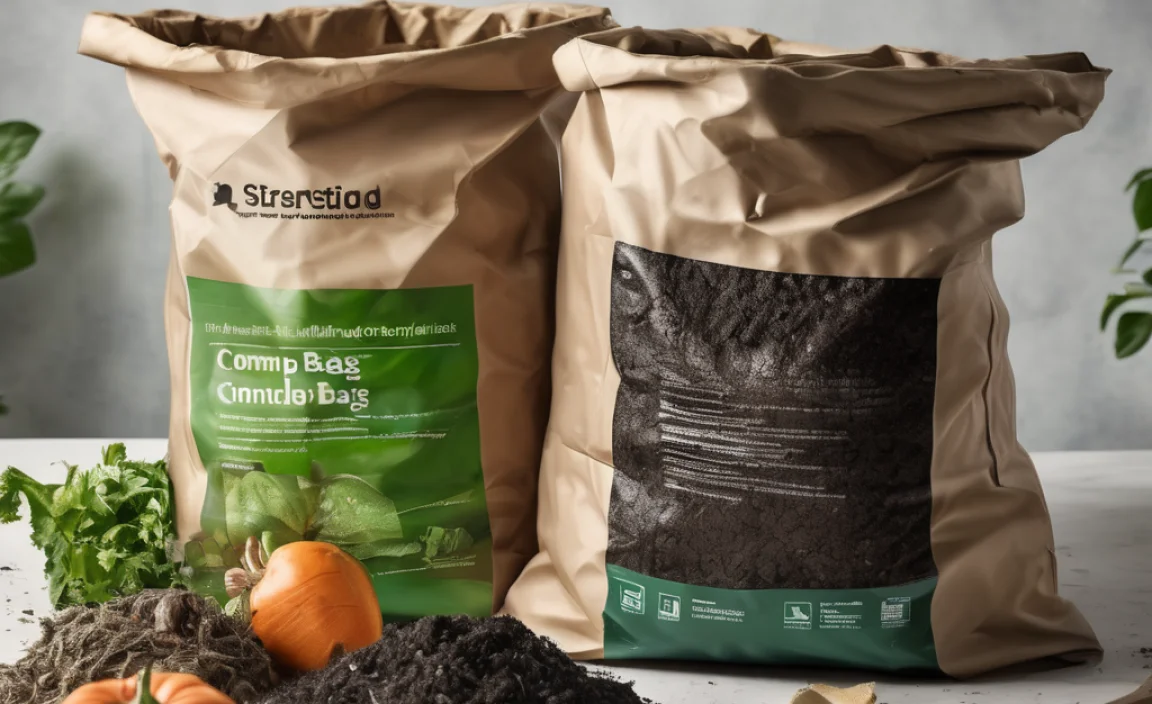
To help you visualize, here’s a quick rundown of commons types often referred to as “compost bags” or used in the composting process:
| Type | Primary Use | Pros | Cons | Ideal For |
|---|---|---|---|---|
| Aerated Fabric Compost Bags | Home composting system | Excellent aeration, lightweight, space-efficient, affordable. | May dry out faster, less pest-proof, can be less tidy. | Small yards, good airflow, budget-conscious. |
| Compost Tumblers/Bins | Home composting system | Faster composting, odor-controlled, pest-resistant, easier to turn (tumblers). | More expensive, can be bulky, potential assembly. | Faster results, odor control, moderate to larger yards. |
| Biodegradable Compost Collection Bags | Collecting kitchen scraps | Convenient, composts with waste, reduces bin cleaning. | More expensive, can be fragile, require proper composting. | Curbside composting, busy kitchens, collecting for larger systems. |
Getting Started with Your Compost Bag
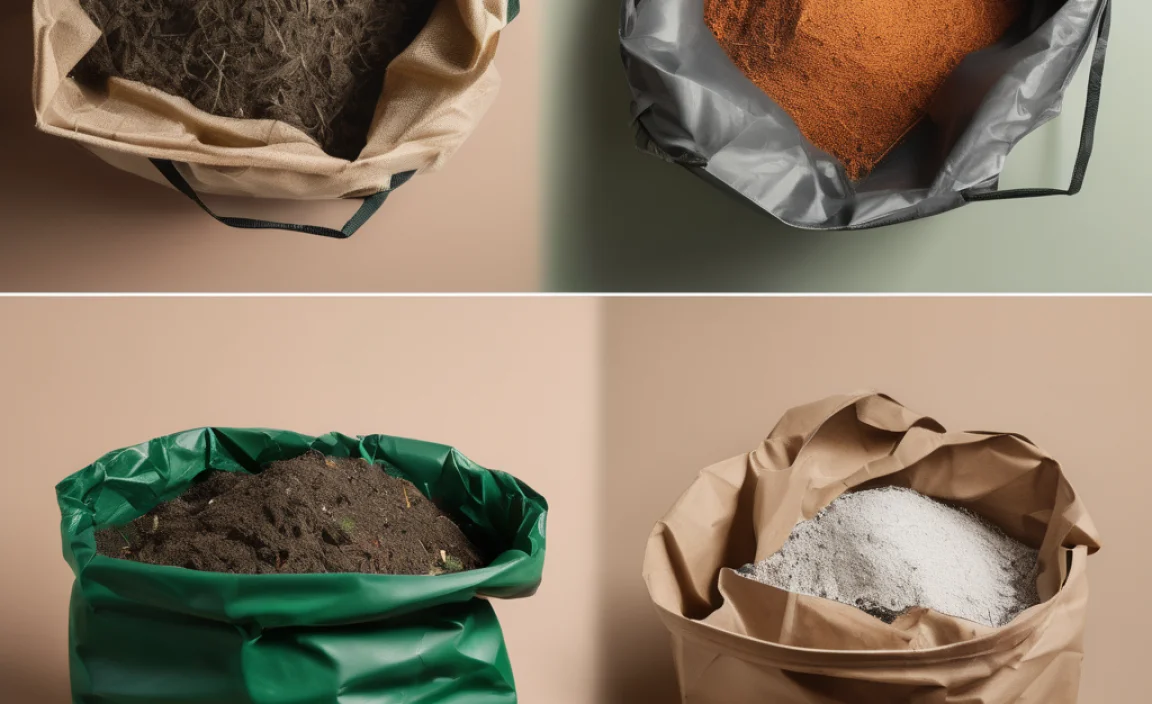
No matter which type of compost bag system you choose, the basic principles of composting remain the same. You need a good mix of “greens” (nitrogen-rich materials) and “browns” (carbon-rich materials), moisture, and air.
What to Compost (Greens & Browns):
Think of it like feeding your compost pile. You need a balance:
- Greens (Nitrogen): Fresh grass clippings, fruit and vegetable scraps, coffee grounds, tea bags, plant trimmings.
- Browns (Carbon): Dry leaves, shredded newspaper/cardboard, straw, sawdust, twigs.
A good rule of thumb is to aim for roughly 2-3 parts browns to 1 part greens by volume.
Moisture Level
Your compost should feel like a wrung-out sponge – damp but not soaking wet. If it’s too dry, decomposition slows down. If it’s too wet, it can become anaerobic and smelly. You may need to add water if it’s dry, or add more browns if it’s too wet.
Aeration
This is where compost bags often shine. Fabric bags allow air to pass through naturally. If you have a rigid bin, ensure the vents are clear, or if it’s a tumbler, give it a few spins every week or so. For any composting method, turning the pile periodically (or letting the tumbler do its job) helps introduce air.
Where to Place Your Compost Bag
Choose a convenient spot that gets some sun but isn’t baking hot all day. This can help kickstart the composting process. Ensure it’s on soil or a surface that allows for drainage, and not directly on a concrete patio that might retain too much moisture.
Using Biodegradable Collection Bags Effectively
If you’re using the smaller biodegradable bags primarily for collecting kitchen scraps:
- Collect Scraps: Keep a small bin in your kitchen for daily fruit peels, veggie scraps, coffee grounds, and eggshells.
- Bag It Up: Once your kitchen bin is full, transfer the contents into a larger certified compostable bag.
- Tie Securely: Close the bag to prevent spills and reduce odors in transit.
- Transfer to Composter/Collection: Empty the bag into your main composting system (if at home) or place it in your designated curbside compost bin. These bags are meant to break down, so don’t put them in your regular trash if you want them to truly compost.
Important Note: Always check with your local municipality if you’re using curbside collection to confirm what type of compostable bags they accept. Not all “biodegradable” or “compostable” bags are created equal, and some facilities have specific requirements to ensure proper breakdown. The EPA also offers guidance on reducing waste and composting at home.
Troubleshooting Common Compost Bag Issues
Even with a compost bag, you might run into a few hiccups. Here’s how to fix them:
- Smelly Compost: This is usually a sign of too much “green” material or not enough air, leading to anaerobic decomposition.
- Solution: Add more “brown” materials (shredded leaves, cardboard) to absorb moisture and balance the nitrogen. Ensure good airflow by turning or fluffing the contents. If using a rigid bin, check that vents are clear.
- Compost is too Dry: Decomposition slows down significantly if the material isn’t moist enough.
- Solution: Add water! Use a hose or watering can to moisten the contents. If using a fabric bag, this is more likely to happen in hot, windy weather. Cover it loosely if very exposed.
- Compost is Too Wet/Slimy: This indicates poor drainage and excessive moisture, often accompanied by bad smells.
- Solution: Add plenty of “browns” to absorb excess moisture. Ensure the bag is in a location with good drainage. If it’s a fabric bag, make sure it’s not sitting in a puddle.
- No Action (Decomposition is too Slow): It could be too cold, too dry, or you might need to add more “greens” to get the microbial activity going.
- Solution: Ensure you have a good mix of greens and browns. Slightly increase the green material if you’ve been heavy on browns. For cooler weather, consider adding a layer of finished compost or manure – it contains active microbes that can inoculate your new batch.
Making the Best Choice for You
Choosing the right compost bag really depends on your space, how much organic waste you produce, and what kind of results you’re looking for. Here’s a quick guide to help you decide:
- For quick, odor-free composting in a small yard: A compost tumbler or a well-designed rigid bin is a great choice.
- For good aeration and a budget-friendly option in a small yard or patio: A geotextile fabric compost bag is excellent.
- If you’re primarily collecting kitchen scraps for a municipal program or a larger home system: Focus on certified biodegradable compost collection bags.
Don’t forget to read reviews and check manufacturer recommendations for specific products. Investing a little time upfront in choosing the right tool will save you a lot of frustration later!
Frequently Asked Questions About Compost Bags
Q1: How long does it take to get compost using a compost bag?
A1: This varies greatly depending on the type of bag, the materials you put in, and the conditions. With good aeration and moisture management in a fabric bag or bin, you might see finished compost in as little as 2-4 months. Tumblers can sometimes speed this up. Traditional open piles or improperly managed bags can take much longer.
Q2: Can I put anything in a compost bag?
A2: Generally, yes for fruit/vegetable scraps, coffee grounds, tea bags, grass clippings, leaves, and small twigs. However, avoid meat, dairy, oily foods, diseased plants, and pet waste (from carnivores) in home composting systems. These can attract pests and cause odors. Always check local guidelines for municipal composting.
Q3: Will compost bags attract pests?
A3: Some types are more pest-resistant than others. Rigid bins and tumblers with secure lids offer the best protection. Open-top fabric bags might be attractive to rodents if not managed carefully or if the composting process isn’t active enough to deter them. Ensuring proper composting temperatures are reached helps make the material less appealing.
.lwrp.link-whisper-related-posts{
margin-top: 40px;
margin-bottom: 30px;
}
.lwrp .lwrp-title{
}.lwrp .lwrp-description{
}
.lwrp .lwrp-list-container{
}
.lwrp .lwrp-list-multi-container{
display: flex;
}
.lwrp .lwrp-list-double{
width: 48%;
}
.lwrp .lwrp-list-triple{
width: 32%;
}
.lwrp .lwrp-list-row-container{
display: flex;
justify-content: space-between;
}
.lwrp .lwrp-list-row-container .lwrp-list-item{
width: calc(25% – 20px);
}
.lwrp .lwrp-list-item:not(.lwrp-no-posts-message-item){
max-width: 150px;
}
.lwrp .lwrp-list-item img{
max-width: 100%;
height: auto;
object-fit: cover;
aspect-ratio: 1 / 1;
}
.lwrp .lwrp-list-item.lwrp-empty-list-item{
background: initial !important;
}
.lwrp .lwrp-list-item .lwrp-list-link .lwrp-list-link-title-text,
.lwrp .lwrp-list-item .lwrp-list-no-posts-message{
}@media screen and (max-width: 480px) {
.lwrp.link-whisper-related-posts{
}
.lwrp .lwrp-title{
}.lwrp .lwrp-description{
}
.lwrp .lwrp-list-multi-container{
flex-direction: column;
}
.lwrp .lwrp-list-multi-container ul.lwrp-list{
margin-top: 0px;
margin-bottom: 0px;
padding-top: 0px;
padding-bottom: 0px;
}
.lwrp .lwrp-list-double,
.lwrp .lwrp-list-triple{
width: 100%;
}
.lwrp .lwrp-list-row-container{
justify-content: initial;
flex-direction: column;
}
.lwrp .lwrp-list-row-container .lwrp-list-item{
width: 100%;
}
.lwrp .lwrp-list-item:not(.lwrp-no-posts-message-item){
max-width: initial;
}
.lwrp .lwrp-list-item .lwrp-list-link .lwrp-list-link-title-text,
.lwrp .lwrp-list-item .lwrp-list-no-posts-message{
};
}

I am passionate about home engineering. I specialize in designing, installing, and maintaining heating, ventilation, and air conditioning systems. My goal is to help people stay comfortable in their homes all year long.

